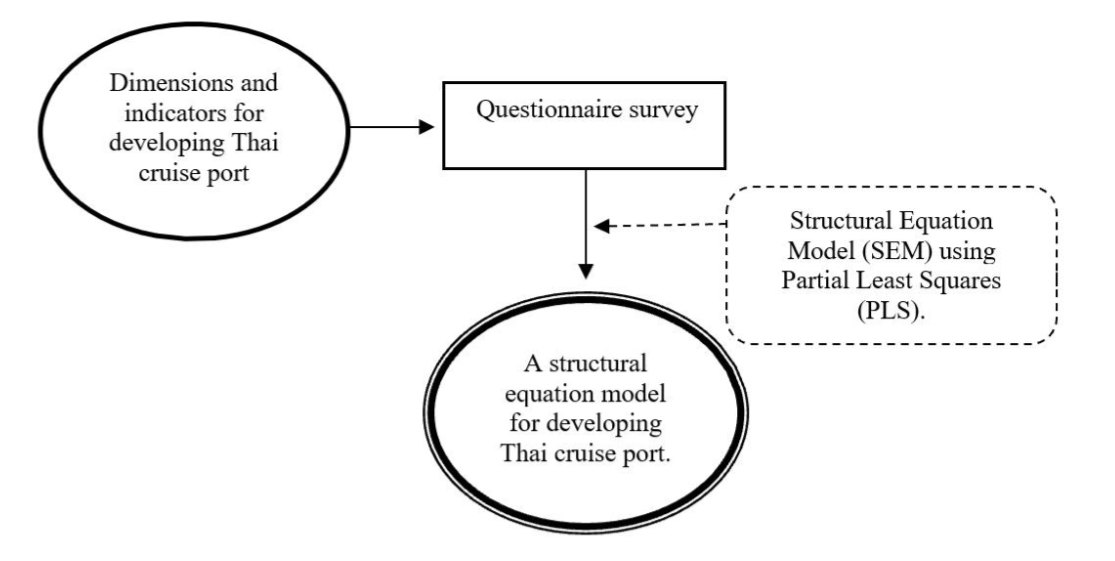Developing a structural equation model: Case study of Thai port developing
Main Article Content
Abstract
The Covid-19 pandemic substantially affects the global tourism industry. The cruise travel business has been one of the most important sources of national income. Therefore, the first need is to improve the cruise ports. This research aims to analyse and develop the structural model of the relationships, dimensions as well as indicators of the cruise port development. The survey research is used in data collection with 342 samples from the Thai tourism business association as well as from the cruise and yacht professionals' association. Three hypotheses drive the indicators to set a relationship among three dimensions that include the cruise tourism factor, the cruise ship characteristics, and the cruise port dimension. Structural equation modelling (SEM) was used to develop this model using the PLS method. The findings revealed that the development of the Thai cruise port model offers the relationship of three dimensions and sixty-nine indicators for improving Thai cruise ports. These results showed a path analysis and measurement model confirming the indicators among these dimensions. The results were also conceptualized into a guideline for how to implement a policy for the cruise port development to support the tourism industry and national economics.
Article Details

This work is licensed under a Creative Commons Attribution-NonCommercial-NoDerivatives 4.0 International License.
References
World Tourism Organization. (2019). WHY TOURISM? Avialable from https://www.unwto.org/why-tourism. [Accessed 10 December 2020]
Eurostat. (2020). Passenger transport statistics. Avialable from
https://ec.europa.eu/eurostat/statistics-explained/pdfscache/1132.pdf. [Accessed 8 March 2021]
Economic Tourism and Sports Division. (2019). Traveler Statistics: 5 Airports.
Avialable from https://www.mots.go.th/more_news_new.php?cid=524. [Accessed 3 March 2021]
Laem Chabang Port. (2018). Information. Avialable from http://lcp.port.co.th/cs/internet/lcp/% E0%B8%82%E0%B9%89%E0%B8%AD%E0%B8%A1%E0%B8%B9%E0%B8%A5%E0%B8%97%E0%B8%B1%E0%B9%88%E0%B8%A7%E0%B9%84%E0%B8%9B.html?page_locale=en_US. [Accessed 12 March 2021]
Ministry of Tourism & Sports (Thailand). (2018). Strategy Promoting Tourism of Cruise 2018 - 2027. Available from https://www.mots.go.th/download/PolicyStrategy/Strategy PromotingTourismOfCruise2561-2570.pdf. [Accessed 8 January 2021]
Wang, Y., Jung, K. A., Yeo, G. T., & Chou, C. C. (2014). Selecting a cruise port of call location using the fuzzy-AHP method: A case study in East Asia. Tourism Management, 42, 262-270.
McCalla, R. J. (1998). An investigation into site and situation: Cruise ship ports. Tijdschrift voor economische en sociale geografie, 89(1), 44-55.
Settadalee, R., & Suthiwartnarueput, K. (2021). Factors for Considering to Develop Thailand Cruise Port. Journal of Srivanalai Vijai.
Piriyakul, M. (2010). Partial Least Square Path Modeling (PLS Path Modeling). 11 th
International conference of Statistics Ramkhamheang University, 29 October 2010.


